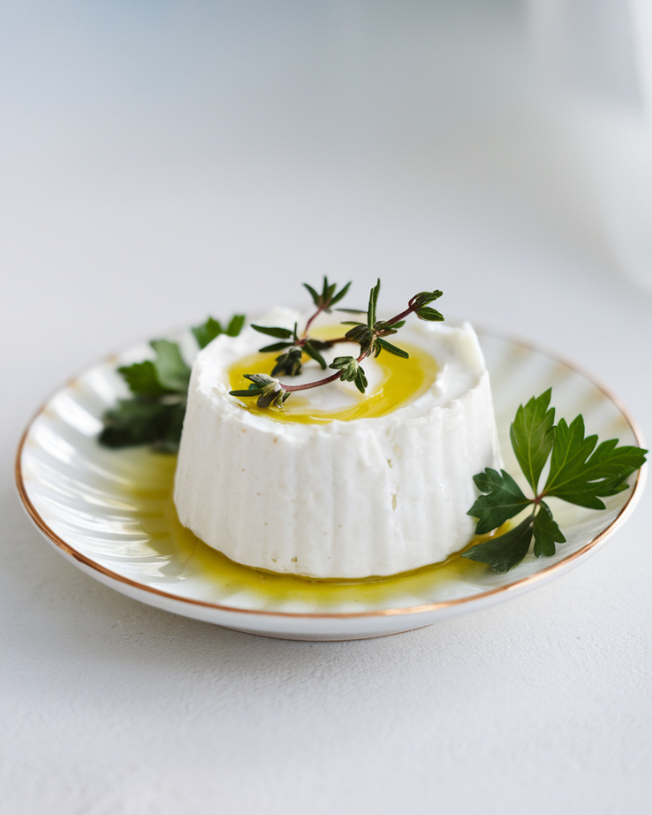Have you ever savored the delightful tang of yogurt cheese, also known as labneh? This creamy spread, a cornerstone of Middle Eastern cooking for generations, is a real kitchen essential. It’s adaptable, tasty, and surprisingly simple to prepare at home. Whether you’re health-conscious, a food lover, or simply eager to try something different, this guide will explain all you need to know about yogurt cheese. I’ll also share some personal advice and dietary alternatives to suit various needs. Let’s get started!
Table of Contents
ToggleWhat is Yogurt Cheese?
Yogurt cheese, or labneh, is a thick, creamy spread created by draining yogurt to extract the whey. A treasured component of Mediterranean cuisine, it’s often enjoyed as a dip, spread, or dessert topping. Picture Greek yogurt’s tangy flavor and cream cheese’s smooth, spreadable consistency—that’s labneh.
A Personal Discovery
I first encountered labneh during a visit to Lebanon some time ago. For breakfast, my host family served it with fresh pita bread, olives, and a drizzle of olive oil. I was immediately captivated. The creamy texture and tangy taste were unique to me. Upon returning home, I was determined to recreate it in my kitchen. After several attempts (and a few messy experiences with cheesecloth), I finally perfected the recipe. Now, it’s a regular item in my refrigerator, and I’m thrilled to share it with you!
Health Benefits of Yogurt Cheese
Yogurt cheese isn’t just delicious—it’s also nutritious. Here’s why you should consider adding this wholesome cheese alternative to your diet:
- Rich in Probiotics
Labneh, being made from yogurt, contains plenty of probiotics—beneficial bacteria that support digestive health. As noted on Wikipedia’s yogurt page, yogurt is a well-known probiotic source, potentially improving digestion, strengthening immunity, and even supporting mental well-being. If you’re seeking a food that’s good for your gut, this fits the bill.
- Protein-Packed
Thanks to its yogurt base, labneh is an excellent protein source. It’s ideal for maintaining fullness and energy throughout the day.
- Lower in Calories
Compared to cream cheese or sour cream, labneh is a lower-calorie cheese option. It’s a worry-free way to add creaminess to your meals.
- Diet-Friendly
Whether you follow a keto, Mediterranean, or vegetarian diet, labneh can easily be incorporated. It’s also a great choice for those looking to reduce their intake of processed foods.
Making Yogurt Cheese at Home
Creating homemade yogurt cheese is surprisingly straightforward. You only need a few basic tools and a bit of patience. Here’s how to do it:
Here’s what you’ll need to whip up some yummy yogurt cheese:
4 cups of regular or Greek yogurt (Greek makes it thicker)
A dash of salt if you like
Grab these tools:
A cheesecloth or fine strainer
A bowl to catch the liquid

Let’s make it:
- Mix it up: Stir in a bit of salt if you want. It adds flavor and helps strain.
- Strain away: Put the yogurt in your cloth or strainer over a bowl. If using cloth, tie it up and hang it.
- Wait it out: Pop it in the fridge for 12-24 hours. The longer it sits, the thicker it gets.
- Dig in: Once it’s ready, put it in a container and enjoy your homemade yogurt cheese!

Handy tip: Keep that liquid! It’s great in smoothies, soups, or even for baking.
Fun ways to use your yogurt cheese:
- Spread the love: Put it on toast, bagels, or crackers. Try it sweet with honey or jam, or savory with herbs.
- Dip it good: Mix in herbs like dill, garlic, or chives for a tasty dip. Great with veggies, pita, or chips.
- Cook it up: Use it instead of cream cheese in cheesecakes or on baked potatoes. It’s also yummy in salads and sandwiches.
- Breakfast boost: Mix with fruit and granola for a healthy start. It’s packed with good-for-you probiotics.
- Sweet treat: Drizzle with honey, add some nuts, and serve with fruit for an easy dessert.
Making it work for different diets:
- Keto-friendly: Use full-fat Greek yogurt and skip the salt. It’s high in good fats and low in carbs.
- Vegan version: Use plant-based yogurt like coconut or almond. It’ll taste a bit different but still creamy and delicious.
- Low-salt option: Just leave out the salt. The yogurt’s tangy flavor is still yummy on its own.
- Sweet twist: Add a bit of honey or maple syrup before straining for a sweet version. Perfect for desserts or breakfast.
If you enjoyed this recipe, I'd love to hear your thoughts! Please leave a ⭐️ rating
and share your experience in the 📝 comments below.

Homemade Yogurt Cheese
Ingredients
- 4 cups plain Greek yogurt or regular plain yogurt
- 1/2 teaspoon salt optional
- Cheesecloth or fine mesh strainer
Instructions
Prepare the Yogurt
- In a mixing bowl, combine the yogurt and salt (if using). Stir well until the salt is evenly distributed.
- Tip: Using Greek yogurt will give you a thicker result, but regular yogurt works well too—just strain it longer.
Set Up the Straining System
If using a cheesecloth:
- Place the cheesecloth over a large bowl, allowing enough overhang to tie it later.
- Pour the yogurt mixture into the center of the cheesecloth.
- Gather the edges of the cheesecloth and tie them together with a string or rubber band to create a bundle.
If using a fine mesh strainer:
- Place the strainer over a large bowl.
- Line the strainer with a double layer of cheesecloth or a clean kitchen towel.
- Pour the yogurt mixture into the lined strainer.
Strain the Yogurt
- Place the bowl (with the cheesecloth bundle or strainer) in the refrigerator.
- Let the yogurt strain for 12-24 hours, depending on how thick you want the final product.
- 12 hours: Yields a soft, spreadable consistency (similar to cream cheese).
- 24 hours: Results in a thicker, more cheese-like texture (ideal for shaping into balls or serving as a dip).
- Tip: Check the consistency after 12 hours. If you prefer it thicker, let it strain longer.
Collect the Whey (Optional)
- As the yogurt strains, the liquid whey will drip into the bowl.
- Save the whey for other uses, such as adding it to smoothies, soups, or baked goods.
Finish and Store the Yogurt Cheese
- Once the yogurt has reached your desired consistency, remove it from the cheesecloth or strainer.
- Transfer the yogurt cheese to an airtight container.
Serve and Enjoy
- Use your homemade yogurt cheese as a spread, dip, or ingredient in recipes.
Video
Notes
- Sweet Version: Add honey or maple syrup before straining.
- Savory Version: Mix in herbs like dill, garlic, or za’atar.
- Storage: Keep in an airtight container in the fridge for up to 1 week.
More Cultured Recipes You’ll Love:
FAQs About Yogurt Cheese
1. How to eat yogurt cheese?
Yogurt cheese (labneh) is versatile! You can:
- Spread it on toast, crackers, or bagels.
- Use it as a dip with olive oil, herbs, and pita bread.
- Mix it into sauces, soups, or salad dressings for creaminess.
- Substitute it for cream cheese or sour cream in recipes.
2. Can you freeze yogurt cheese?
Yes, but the texture may change. Freezing can cause yogurt cheese to become grainy and watery when thawed. If you must freeze it, store it in an airtight container and stir well after defrosting.
3. Does yogurt go bad easily?
Yes, yogurt can spoil if not stored properly. Keep it refrigerated and consume it before the expiration date. If it smells sour, has mold, or has an unusual texture, discard it.
4. What is the best way to eat yogurt?
The best way depends on your preference! Enjoy it:
- Plain with honey, nuts, or fruit.
- Blended into smoothies.
- As a base for salad dressings or dips.
- Swirled into soups for a creamy texture.
5 Mistakes to Avoid When Making Yogurt Cheese
Using the Wrong Type of Yogurt
Always choose plain, full-fat yogurt for the best texture and flavor. Avoid yogurts with added sugars, thickeners, or artificial flavors, as they can affect the final consistency of your yogurt cheese.Skipping the Straining Time
Rushing the straining process will leave you with a watery consistency instead of thick, creamy cheese. For best results, let it strain for at least 12–24 hours in the fridge.Not Using a Fine Mesh or Cheesecloth
A loose strainer or regular cloth may let some yogurt escape, leading to a lower yield. Use a fine mesh sieve or multiple layers of cheesecloth to properly separate the whey.Squeezing the Cheese Too Much
While it may be tempting to speed up the process by pressing or twisting the cloth, doing so can result in a grainy texture instead of a smooth and creamy consistency. Let gravity do the work!Throwing Away the Whey
The liquid whey strained from the yogurt is packed with probiotics and protein—don’t waste it! Use it in smoothies, soups, bread-making, or even fermenting vegetables
Have you tried yogurt cheese? It’s not just a tasty snack—it’s a fantastic addition to your culinary repertoire. This simple-to-prepare dairy product offers numerous health advantages and can be used in many different ways. Whether you’re an experienced chef or new to cooking, you’ll be impressed by this smooth and creamy spread. Ready to give it a go? All you need is some plain yogurt and cheesecloth to make this no-cook cheese at home. Once you’ve made your own labneh, why not share how you’ve used it? I’d be thrilled to hear about your culinary creations in the comments section!
Looking for more delicious meal ideas? Check out our Lunch Recipes and
dinner recipes to keep your day flavorful and balanced

